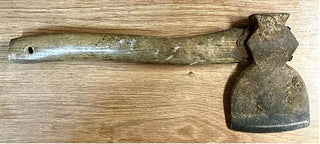A side effect of people knowing I am a Bushcrafter is occasional gifts of odd tools. In this case I was offered a rusty axe but one that had an intriguing head shape that was not the same as a typical woodland axe.
I took the option to “Phone a Friend”, who knows more about tools than I ever will, and he identified it as a Carpenters Axe designed for flattening/smoothing out a piece of wood. Unlike most general purpose axes it has a flat grind rather than a convex grind which is designed to assist with a consistent angle of attack on the wood and therefore a better finish.
To bring this axe back to life I started by removing the handle. It was missing the knob (the piece at the base of the handle that protrudes forward and stops your hand slipping off) and was wedged in the head of the axe with 3 rusty square nails. To start the process of cleaning the head itself I used a high grit flap wheel in my drill. This isn’t too abrasive but was sufficient to take off the outer layer of rust and corrosion. Under that layer I found a small logo that looked like a snail and the number 1.

An internet search turned up a selection of posts and blogs on old tool sites that identified this as a Number 1 Carpenters Axe from the Snail Brand company. Thomas Smith and Sons of Saltley in Birmingham were the original manufacturer. The owner is said to have chosen a Snail as a logo because “the Snail may be slow but he gets there in the end”. The style of logo suggests this axe is from 70s or 80s so it’s a good age.
Knowing a bit more about it and that I was a quality tool a I set to the remainder of the rust with wire wool which cleans but leaves some of the patina intact, this is going to be a working tool not a shiny "as new" restoration. The hammer head on the rear of the Axe head had clearly seen a lot of use so I filed down the sharp burrs on the side and flattened an area of the head for more accurate striking.

The handle was beyond repair, the top section had been chewed up by repeated addition of metal nails and there wasn’t sufficient wood left to make a safe fit into the head. Searching in my local farm shop I found an Ash handle that was almost identical in size and shape to the original.
Fitting the handle to the head took some time as the pronounced lugs top and bottom were digging into the handle. The trick here is to test fit then carefully carve out the high spots taking care not to cut away too much. Below you can see where I’ve marked the angle to carve on the handle and also where the inside of the Axe head is rubbing. This is a part of the job that is worth taking time over. A well fitting handle is important, you don’t want the head flying off mid use!


Eventually I reached a point where the handle slid far enough up to extend beyond the upper lug whilst still being a snug fit. Removing the handle I used a saw to cut the handle across the wood, from front to back, down to approximately 2/3 of the head height. This created space for a wedge to be inserted without the risk of splitting the handle. A piece of well seasoned Ash was trimmed to a thin wedge.


The wedge was then encouraged (using a wooden mallet) into the slot which firmly fixed the handle in place. I finished by trimming the handle to the profile of the head.

The final stage was to tackle the cutting edge which was so blunt it looked like it had been used to dig rocks. Being a flat grind it was easy enough to use a hand file to reprofile the grind to something approximating an edge then onto my wet stones from coarse to fine grit to bring it back to sharpness.
As I mentioned earlier this is going to be a working tool so of course I needed to test it out. I split an Ash round into a thick plank and used the Carpenter’s Axe to finish the surfaces. It certainly made quick work of any irregularities and within a short time I had a squared off plank that could be used in some form of Bushcraft construction.

I did identify that I need to spend more time bringing the edge to real sharpness and of course it’ll need a cover but that’s a project for another day. For now I have a nice axe to add to my collection, not one for everyday use in the Woods but if I plan on building something it will certainly be in my tool roll. Even the old handle isn’t going to be wasted, there’s enough good wood remaining to provide handles for a pair of knives I’m making.

